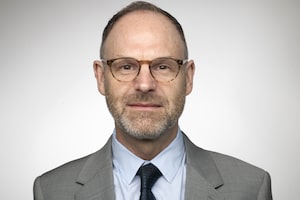A Hydro Quebec worker walks back to his truck after inspecting a substation in Delson, Quebec, on Oct. 12, 2022.Christinne Muschi/Christinne Muschi/The Globe and
Michael Sabia had barely started his new job at Hydro-Québec when the provincially owned utility best known for its massive hydroelectric dams said it is taking a renewed look at nuclear power, as it seeks to dramatically increase its energy supply by mid-century.
Mr. Sabia, who took over as Hydro-Québec’s chief executive on Aug. 1, has a mandate from Premier François Legault to add thousands of megawatts to the Quebec’s electricity grid to help the province achieve its net-zero carbon goal by 2050. And an Aug. 10 Journal de Montréal article revealed that the new CEO has already commissioned a feasibility study on relaunching the Gentilly-2 nuclear power station that Hydro-Québec shut down in 2012.
Hydro-Québec subsequently acknowledged “an evaluation on the current state of the station is underway to evaluate our options and to feed our reflection on Quebec’s future energy offering,” adding “it would be irresponsible at this time to exclude certain energy sectors.”
Quebec turned its back on nuclear power in the wake of the 2011 Fukushima nuclear disaster in Japan. Former premier Pauline Marois’s short-lived Parti Québécois government announced the shuttering of the 675-megawatt Gentilly-2 station shortly after taking power in 2012. By then, Hydro-Québec had already spent almost $1-billion on a planned refurbishment of Gentilly’s 29-year-old CANDU reactor to extend its operating life to 2040.
At the time, the shale gas boom had sent U.S. electricity prices tumbling, undermining Hydro-Québec’s export ambitions, while the projected cost of Gentilly-2′s refurbishment had doubled to $4.3-billion. Ms. Marois’s government, with its strong anti-nuclear bent, pulled the plug on the project. Hydro-Québec took a $1.9-billion write-down on Gentilly-2 and slashed its dividend to the government to $645-million in 2012 from almost $2-billion in 2011. The utility began decommissioning Gentilly-2 in 2013.
Now, with Mr. Sabia in the saddle at Hydro-Québec under a pro-development Coalition Avenir Québec government, the stars appear to have aligned for a renewed push into nuclear power. The Gentilly-2 site in Bécancour, Que., sits adjacent to an industrial park that is rapidly becoming a hub for energy-hungry electric-battery component manufacturers, with major investments by Ford and General Motors in partnership with South Korean players.
A Hydro-Québec spokesperson told Le Journal de Montréal that the utility is exploring whether it is possible to halt the decommissioning of the existing reactor at Gentilly-2 and proceed instead with its refurbishment. But Quebec Economy Minister Pierre Fitzgibbon subsequently appeared to rule out that option. Instead, he said the focus will be on small modular reactors or next-generation large-scale nuclear reactors.
Montreal-based SNC-Lavalin Inc. SNC-T could benefit if Hydro-Québec decides to invest in nuclear power again. SNC-Lavalin purchased the CANDU business from the federal government in 2011. The Mississauga, Ont.-based nuclear division generated more than $800-million in revenue in 2022, much of it from decommissioning activities. But the company is banking on a renewed push into nuclear power as net-zero efforts gain momentum.
“The world has changed in terms of attitude to new nuclear power, and it needs to,” SNC-Lavalin CEO Ian Edwards said on a call with analysts this month. “Because if we are going to reach net zero, we need nuclear power as a base load to that clean energy future.”
As CEO of Caisse de dépôt et placement du Québec between 2009 and 2019, Mr. Sabia oversaw a major investment in SNC-Lavalin that saw the pension fund become the company’s largest shareholder with a 20-per-cent stake, increasing its holding to almost 35 million shares from five million in 2009. The shares tanked after SNC-Lavalin was hit with fraud and corruption charges related to its former activities in Libya. But the Caisse’s stake has surged in value, from $833-million at the end of 2022 to $1.5-billion so far this year.
SNC-Lavalin’s brighter nuclear prospects are one reason why. In May, it hired former Ontario Power Generation nuclear executive Gary Rose to oversee its Candu Energy division with an eye to expanding the business.
In July, SNC-Lavalin partnered with GE Hitachi and Aecon on the world’s first commercial contract for a small modular reactor, to be installed at OPG’s Darlington nuclear generating station by 2028. The project will use GE Hitachi’s BWRX-300 SMR technology, rather than SNC-Lavalin’s CANDU SMR. SNC-Lavalin said its role will be to “provide OPG with a diverse range of expertise for the engineering and build” of the Darlington SMR, including “project management, licensing, engineering, design, procurement, construction support and commissioning.”
SNC-Lavalin is also eyeing a piece of the pie (if not the entire pie), as Bruce Power begins pre-development work with the Ontario government that could lead to a massive expansion of what is already the continent’s largest nuclear plant, adding 4,800 MW to its current 6,400 MW of capacity.
“SNC-Lavalin believes that CANDU technology is the clear choice for new large nuclear reactor builds in Canada,” Mr. Rose last month told Platts Nucleonics Week. “We have the infrastructure, supply chain and human capacity to deploy CANDU technology, maximizing the economic value to Canada and providing ongoing energy security.”
Mr. Sabia, who kept a close eye on SNC-Lavalin while at the Caisse before going on to become deputy finance minister in Ottawa, no doubt agrees with that.
 Konrad Yakabuski
Konrad Yakabuski